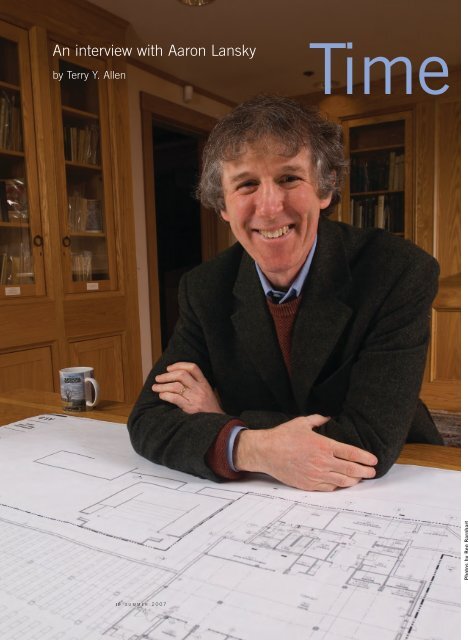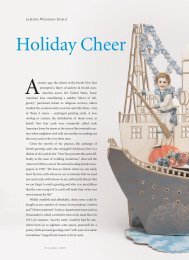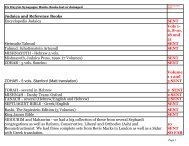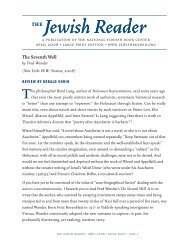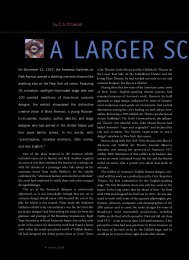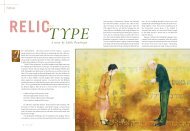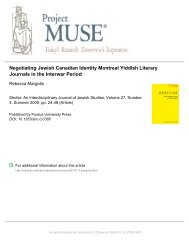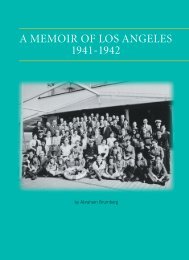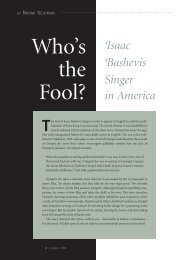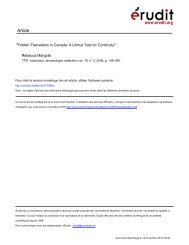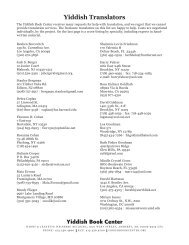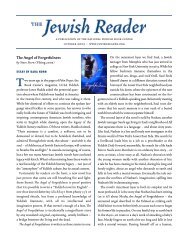An interview with Aaron Lansky - Yiddish Book Center
An interview with Aaron Lansky - Yiddish Book Center
An interview with Aaron Lansky - Yiddish Book Center
Create successful ePaper yourself
Turn your PDF publications into a flip-book with our unique Google optimized e-Paper software.
<strong>An</strong> <strong>interview</strong> <strong>with</strong> <strong>Aaron</strong> <strong>Lansky</strong><br />
Time<br />
by Terry Y. Allen<br />
16 SUMMER 2007
Photos by Ben Barnhart to<br />
build again<br />
Architectral Renderings by James Akers.<br />
Last spring Pakn Treger talked <strong>with</strong> the National <strong>Yiddish</strong><br />
<strong>Book</strong> <strong>Center</strong>’s president and founder <strong>Aaron</strong> <strong>Lansky</strong> about the<br />
organization’s bold plans to place <strong>Yiddish</strong> language, literature,<br />
and culture squarely in the main-<br />
stream of Jewish education. The<br />
beautiful new facility that will<br />
house the initiative, depicted in<br />
the architectural drawings on these<br />
pages, will open to the public this<br />
coming year.<br />
17 PAKN TREGER
TA: The <strong>Book</strong> <strong>Center</strong> is 27 years old, there are 30,000 members,<br />
you’ve saved countless books from the landfill and provided<br />
a home for the cultural extension of <strong>Yiddish</strong>. You’ve<br />
digitized the collection and translated major works into<br />
English. Many people would say it’s time to rest on your laurels.<br />
What do you say to that?<br />
AL: I would say we’ve only just begun. The first thing was to<br />
save the physical books, to secure access to the culture. <strong>An</strong>d I<br />
can’t exactly say that job is done. Even at this late date, we’re<br />
still receiving 200 to 300 books a week. Last April we sent<br />
two people down to Sao Paolo, Brazil, to retrieve 3,000<br />
books in a building that was about to be torn down. <strong>An</strong>d of<br />
course now we’re working to place almost all our titles<br />
online, which will make the whole literature accessible and<br />
searchable.<br />
TA: For anybody?<br />
AL: For anybody, anywhere in the world, for free. But there is<br />
a much greater job still waiting. Now that the books are<br />
largely safe, the next obvious step is:“So how do you open up<br />
these books and share their contents <strong>with</strong> the world?”<br />
Because bound up inside this literature is essentially 1,000<br />
years of Jewish experience as well as the Jews’ first sustained<br />
literary encounter <strong>with</strong> the modern world. Very simply, if we<br />
want to know who we are, we need to find out what lies<br />
<strong>with</strong>in the books. The <strong>Book</strong> <strong>Center</strong> holds the largest single<br />
collection of Jewish books anywhere in the world and the<br />
largest collection of Jewish books ever assembled in Jewish<br />
history. That puts a pretty big responsibility on us.<br />
TA: So there’s no resting on laurels?<br />
AL: I don’t think I’ve rested on a laurel, ever! But I have to tell<br />
you, I’ve never been more excited about what comes next.<br />
After 27 years of rounding up all the books, now we get to<br />
open them up, and we begin to transform American Jewish<br />
life by giving Jews a new understanding of who they are, of<br />
where they come from.<br />
TA: What does it mean to “open up the books”?<br />
AL: We want to give Jews a sense of their own history, literature,<br />
and culture. So our big step forward is to launch a<br />
“<strong>Yiddish</strong> academy,” a <strong>Yiddish</strong> university, an educational<br />
center where people of all ages can come and discover this<br />
literature in a serious, substantive but also a really lively,<br />
exciting way.<br />
18 SUMMER 2007<br />
TA: A yeshiva?<br />
AL: Well, that’s wonderfully alliterative <strong>with</strong> <strong>Yiddish</strong>, but not<br />
quite it. “Yeshiva” has a religious ring to it. In fact, it’s really<br />
difficult to find the right term for what we’re planning,<br />
because all the Jewish words for education come from a religious<br />
context and still hold religious connotations. <strong>An</strong>d all the<br />
English words tend to be Greek or Latin:“academy” and “university”<br />
and “lyceum.” Nothing quite fits what we’re doing.<br />
TA: You’ll let us know when the word–<br />
AL: I don’t think we’re going to get the word exactly. Which is<br />
actually a good sign, because it means what we’re doing is<br />
novel and original, a whole new model. Jews today are living<br />
in the aftermath of the Holocaust, when the universe of<br />
Jewish life in Eastern Europe was essentially destroyed. It<br />
took time to regain our bearings after a calamity of that magnitude.<br />
There have been tremendous pressures to obliterate<br />
memory of this culture on many fronts – everything from<br />
Israel’s trying to find a new beginning and erase the Diaspora<br />
past, to America’s melting pot, where differences of religion<br />
were acceptable but differences of culture were not. So Jews<br />
in America inadvertently redefined themselves in Christian<br />
terms, reducing Jewish identity to a religion – a religion<br />
divorced from culture.<br />
So we understand all that’s happened historically. But, as<br />
we say in <strong>Yiddish</strong>, it’s shoyn tsayt. It’s time to begin to reclaim<br />
what we’ve lost, to come to terms <strong>with</strong> <strong>Yiddish</strong> language,<br />
<strong>with</strong> modern Jewish literature, <strong>with</strong> Jewish history and in<br />
particular Jewish social history: how Jews lived their lives.<br />
That includes folklore and ethnography and music and journalism<br />
and theater and film. There’s a vast constellation of<br />
culture out there that we know remarkably little about.<br />
Look at the curriculum of Jewish day schools around the<br />
country. The schools are burgeoning and most are really<br />
good: bright kids, excellent teachers. Yet the curriculum is<br />
inexplicably limited in scope in Jewish terms. Essentially, kids<br />
are learning ancient texts in Hebrew and Aramaic, but they’ll<br />
graduate after 12 years never having heard of Sholem<br />
Aleichem, I. L. Peretz, or Isaac Bashevis Singer, who won the<br />
Nobel Prize in Literature. Or of modern Hebrew writers like<br />
Bialik or Agnon, another Nobel Prize winner, or of American<br />
Jewish writers like Philip Roth, Saul Bellow, Grace Paley.<br />
None of them is included in the curriculum. There’s obviously<br />
something huge that’s missing from contemporary<br />
Jewish life. Our goal is to make all that accessible once again.<br />
There’s a wonderful term in <strong>Yiddish</strong>: a lebedike velt – a lively<br />
world. That’s exactly how we envision this new center.
TA: A lively world?<br />
AL: Yes, it will be busy constantly, year round, <strong>with</strong> innovative<br />
programs and courses, seminars and events, a place<br />
where people can come to discover this culture and make it<br />
their own. For instance, we’re going to start a<br />
<strong>Yiddish</strong> ulpan. Ulpanim are the Hebrewlanguage<br />
immersion programs developed in<br />
Israel. We’ll be creating a similar program for<br />
<strong>Yiddish</strong>, offered to adults, college students,<br />
high school students, on beginning, inter-<br />
mediate, and advanced levels. Participants will come for<br />
a weekend, or a week, maybe even a month at a time.<br />
TA: So language immersion is the first aim of this program?<br />
AL: That is one of the first aims. But <strong>with</strong> <strong>Yiddish</strong> you can’t<br />
immerse yourself in language <strong>with</strong>out immersing yourself in<br />
the culture as well. It’s a package deal, and it’s going to be a lot<br />
of fun. People will immerse themselves in language, and<br />
there will also be music, films, theatrical presentations, readings,<br />
and more.<br />
Our second objective involves college students. We had<br />
3,000 hits on our Web site for 18 positions for our summer<br />
internship program. This summer we’re just a hair shy of<br />
100 percent over applications from last year. That means<br />
we’re going to have to turn away roughly nine out of every<br />
ten students who apply. There’s something wrong <strong>with</strong> this<br />
picture, right? The rest of the Jewish community is pouring<br />
“Our big step forward is to open a<br />
kind of ‘<strong>Yiddish</strong> academy,’ a <strong>Yiddish</strong><br />
university, an educational center<br />
where people of all ages can come<br />
and discover this literature in<br />
a serious, substantive but also<br />
a really lively, exciting way.”<br />
millions of dollars into trying to figure out how to reach<br />
young people – and in the meantime we’re literally turning<br />
young people away.<br />
So we want to dramatically expand our internship opportunities.<br />
Right now we have an eight-week program and<br />
most students come to us <strong>with</strong> no prior <strong>Yiddish</strong> knowledge.<br />
We give them a full-credit course in <strong>Yiddish</strong> language and<br />
another one in <strong>Yiddish</strong> literature and Jewish history and culture.<br />
They spend the rest of the day opening up boxes and<br />
getting hands-on work experience. Right now we’re taking<br />
18 students a summer. Once we open our new center, once<br />
we have the physical space to accommodate everybody, we’ll<br />
expand the program to 45 students each summer. Then we’ll<br />
introduce a winter session as well.<br />
TA: Are these to be paid internships?<br />
AL: Yes, we pay the students to come. They work very hard –<br />
19 PAKN TREGER
ut they are working <strong>with</strong> <strong>Yiddish</strong> books, <strong>Yiddish</strong> knowledge,<br />
rather than having to work at menial summer jobs to make<br />
money. We want the best students, regardless of need.<br />
TA: <strong>An</strong>d there will still be boxes of books for them to open?<br />
AL: I’d say in about a hundred years, we might run out, but at<br />
the moment there’s no shortage of books. Of course, one of<br />
the great benefits of the educational center we’re building<br />
here will be a 10,000-square-foot library.<br />
TA: A repository?<br />
AL: Yes, a repository for our most important titles. It will be<br />
rather cold – 55 degrees, 35 percent humidity year round, in<br />
order to preserve the books. You’ll pass through an airlock to<br />
get into it, but once you’re through the airlock and put on<br />
some warm clothes, you’ve got a lot of work to do. It’s not<br />
only a matter of opening boxes, which is the immediate work,<br />
but also indexing literature, indexing periodicals. We’ll be<br />
sending students out to collect oral histories and to do all<br />
sorts of related projects: digitization of music, collection of<br />
archival materials. This is not token work. Usually internship<br />
programs have kids Xeroxing papers in an office somewhere.<br />
20 SUMMER 2007<br />
The experience here involves dusty, backbreaking work that<br />
only young people can do. It takes strength, energy, and fortitude.<br />
The students really throw themselves into it. Eighteen-,<br />
nineteen-, twenty-year-olds don’t always have a chance to<br />
make a difference in the world. So that’s number two: expansion<br />
of the internship program.<br />
TA: <strong>An</strong>d the third?<br />
AL: The third will be geared toward high school students.<br />
TA: Some kind of in-house immersion?<br />
AL: Yes, in <strong>Yiddish</strong> language and modern Jewish culture, <strong>with</strong><br />
plenty of opportunities for learning by doing, including<br />
hands-on work. High school kids can be every bit as engaged<br />
as college students.<br />
<strong>An</strong>d the fourth, initial aspect of our programs is a distance-learning<br />
center. It will be a state-of-the-art studio,<br />
where we can offer courses and broadcast programs over the<br />
Internet. We’ll probably do this through a local college or<br />
university, but we haven’t made the final arrangements yet.<br />
TA: For credit?<br />
R<br />
emember those <strong>Yiddish</strong> books you dropped<br />
off at the National <strong>Yiddish</strong> <strong>Book</strong> <strong>Center</strong> in<br />
shopping bags or grocery boxes, months or<br />
even years ago? For five weeks last spring, <strong>Book</strong><br />
<strong>Center</strong> staff and a crew of 12 repacked hundreds<br />
of thousands of <strong>Yiddish</strong> books that had been<br />
stored since 1984 in a 19th-century brick mill<br />
building in Holyoke, MA. The result was an<br />
awesome sight: nearly 13,000 numbered,<br />
uniform, acid-free boxes neatly stacked<br />
and shrink-wrapped onto 323 pallets.<br />
The pallets were loaded into 48-foot<br />
commercial trucks and driven to a highsecurity<br />
warehouse facility nearby, where<br />
individual boxes and books can be easily<br />
located through a computerized retrieval<br />
system, whenever they’re needed.
AL: Yes, there will be full-credit courses in <strong>Yiddish</strong> language<br />
and <strong>Yiddish</strong> literature. The world is moving in this direction.<br />
I don’t think anything can quite take the place of actually<br />
being here, but it’s a good start. The saying in <strong>Yiddish</strong> is<br />
forshpayz, an appetizer, a warm-up for what’s to come.<br />
TA: <strong>An</strong>d this will be for anybody who signs up?<br />
AL: <strong>An</strong>yone, anywhere in the world. As far as possible, we<br />
want to make these programs responsive and self-sustaining.<br />
TA: Who will be your faculty?<br />
AL: We know many of them already – people like Ilan<br />
Stavans at Amherst College, who is a member of our board<br />
and a contributor to Pakn Treger; and Naomi Seidman, who<br />
was actually an intern here when the program first started<br />
and is now Koret Professor at Berkeley’s Graduate<br />
Theological Union. We are able to attract the very best<br />
people in the field. There will also be a director of the education<br />
center – a dean or a provost responsible for curriculum<br />
and program development, whose background is in <strong>Yiddish</strong><br />
culture. There may be other people – an in-house language<br />
instructor, scholars-in-residence, that sort of thing.<br />
Collection Manager<br />
<strong>Aaron</strong> Rubinstein at work<br />
orchestrating the packing<br />
and moving in Holyoke.<br />
TA: Is any of this going to be available to the local community?<br />
I’m thinking of performances and lectures, which are so<br />
popular.<br />
AL: Of course. We already offer wonderful weekly public<br />
programs, and we’re going to expand them. The new<br />
building will include a large multipurpose space, which can<br />
be used as a performance hall for audiences of up to 275. Our<br />
present theater, which is beautiful, a magical space, <strong>with</strong> perfect<br />
acoustics, holds only 78 people. It’s just right for much of<br />
what we do, but frequently we have to turn away two or three<br />
times as many people as we can accommodate. Sometimes<br />
we have to run repeat performances or screenings. Our new<br />
performance hall will have full theatrical capability, so we’ll<br />
be able to stage dance performances and big theatrical productions.<br />
There’ll be a large kosher kitchen to accommodate<br />
participants who attend our conferences and workshops.<br />
TA: Have you been rolling out this four-point program when<br />
you go on the road?<br />
AL: Yes. <strong>An</strong>d people really like it. <strong>An</strong>d these are just the first<br />
four goals of the education program. I guarantee that another<br />
dozen ideas will follow. You know, some people think I must
have a hard time coming up <strong>with</strong> new ideas. I’m almost<br />
embarrassed to tell them that my job is more about tamping<br />
down the ideas and picking the ones that we can realistically<br />
do or that will have the greatest impact. We have a very talented<br />
staff and they’re always bubbling over <strong>with</strong> suggestions.<br />
In <strong>Yiddish</strong>, they say a bisl un a bisl makht a fule shisl: a little<br />
bit of everything makes a full plate. It’s very true in this case.<br />
We’ll start small and realistically and then steadily grow.<br />
TA: So the beginning is education?<br />
AL: The beginning and the end is education. It’s the process<br />
of sharing a culture. <strong>An</strong>d not only for Jewish audiences.<br />
<strong>Yiddish</strong> represents a world literature and a culture that’s<br />
deserving of a diverse worldwide audience. We certainly find<br />
that in our internship program: many students are Jewish,<br />
but many are not. A lot of people come from complex backgrounds.<br />
Young people <strong>with</strong> one Jewish parent or one Jewish<br />
grandparent ask: Who are we? What’s this all about?<br />
TA: You’ve been in the <strong>Yiddish</strong> cultural and literature business<br />
for almost 30 years. Have you noticed a difference in the<br />
wider public’s understanding of and appreciation for<br />
<strong>Yiddish</strong>?<br />
AL: Yes. It’s been dramatic. In 1978, Isaac Bashevis Singer, a<br />
great <strong>Yiddish</strong> writer, won the Nobel Prize for Literature.<br />
Perhaps that was the start. As Bashevis Singer himself said in<br />
Stockholm, the award was not only recognition of his writings;<br />
it was recognition of <strong>Yiddish</strong> itself. In some ways,<br />
<strong>Yiddish</strong> literature is the quintessential modern literature. It<br />
doesn’t begin until the 1860s. It was a literature in which a traditional<br />
society met the modern world, so it has all the great<br />
themes of modern literature: the emergence of the individual;<br />
the working out of new sexual mores between men and<br />
women; the issues of generational conflict, of power and<br />
powerlessness. I think that explains a lot of its universal<br />
appeal. For example, Sholem Aleichem, who wrote in the<br />
early years of the 20th century, has been translated into 30<br />
languages and is today more popular than ever in Japan,<br />
which is a culture intensely concerned <strong>with</strong> issues of tradition<br />
and change. Sholem Aleichem speaks directly to those issues.<br />
TA: Back to your plans for education.<br />
AL: To make all this possible, we simply need more space. We<br />
opened the doors to our existing building ten years ago. <strong>An</strong>d<br />
although we were certainly looking to the future, we were still<br />
largely focused on the most urgent work at hand, which was<br />
22 SUMMER 2007<br />
rescuing the books, processing the books, cataloging the<br />
books. That’s what this building was primarily designed for.<br />
So as you walk into the building, you look down from a balcony<br />
level into the centerpiece of the building: our very large<br />
book repository, <strong>with</strong> row after row of <strong>Yiddish</strong> books.<br />
Now one of the things we couldn’t have known ten years<br />
ago was just how many books we’d end up collecting. People<br />
walk in here today and say, I’ve never seen so many books in<br />
one place in my life! But the truth of the matter is that the<br />
books here represent less than 10 percent of our collection.<br />
The rest are stored in a 19th-century mill building in<br />
Holyoke, 12 miles away. Our original idea was to allow people<br />
to look at the books in this building, but not handle them. We<br />
thought of the books as cultural artifacts that had to be protected.<br />
<strong>An</strong>d the books were all there was ten years ago.<br />
TA: So it was an exhibition, in a manner of speaking?<br />
AL: In a sense. Of course, we had extensive museum exhibitions<br />
upstairs, which were designed to explain this culture to<br />
a broader public – the 99 percent of our visitors whose<br />
<strong>Yiddish</strong> is imperfect at best. The 10,000 people who come<br />
each year want to understand the culture, but very, very few<br />
can actually read these books.<br />
TA: What changed?<br />
AL: Not long after we moved into the building, it became<br />
apparent that there were still two very real problems to be<br />
overcome, even though the books themselves finally had a<br />
permanent home. First, even <strong>with</strong> all the volumes we’d collected,<br />
we didn’t have enough copies of the most critical titles<br />
to meet demand. For example, The Brothers Ashkenazi by I. J.<br />
Singer is arguably the greatest <strong>Yiddish</strong> novel ever written. We<br />
have only a few copies in this entire collection! Not that the<br />
book wasn’t widely read, but it was so well read, so much in<br />
demand, that few copies survived. Can you imagine an analogous<br />
situation in any other literature? Suppose that in all<br />
the libraries and all the bookstores in the world there were<br />
three copies left of War and Peace, three copies of Moby Dick.<br />
The United Nations would be convening an emergency session<br />
to deal <strong>with</strong> the crisis!<br />
Well, we had that problem, along <strong>with</strong> the fact that so<br />
many of the books we had collected were printed on poor<br />
quality wood pulp paper, which has a very short life and is<br />
particularly vulnerable to pollution. Unlike today’s cotton<br />
rag paper, it begins to decay very quickly, it becomes yellow<br />
and brittle. A lot of our books are literally crumbling,<br />
falling apart. So we decided to digitize the literature.
TA: How long did that take?<br />
AL: Five years. Thanks to Steven Spielberg’s Righteous<br />
Persons Foundation, the David and Barbara Hirschhorn<br />
Foundation, and dozens of other generous donors, we were<br />
able to use the latest technology to scan and store every page<br />
of approximately 13,000 discrete titles – almost four million<br />
pages, all of <strong>Yiddish</strong> literature compressed into files and<br />
stored on disks that fit into a shoebox. Now we can<br />
present a brand new, library bound, acid-free reprint<br />
edition of each title, on demand. <strong>An</strong>d our latest project<br />
is to place the content of most of these books online, in<br />
fully searchable form, making <strong>Yiddish</strong> literature<br />
instantly accessible to everyone, everywhere. The effect<br />
of these breakthroughs is to make the “artifactual”<br />
books – the originals we’ve collected – less sacred.<br />
Suddenly we could let people touch the used books in<br />
the stacks, we could lower the price of each volume.<br />
That was part of what began to change our way of<br />
thinking.<br />
TA: But that’s not the whole story.<br />
AL: No, not at all. The real issue becomes education. We<br />
always knew that we would want to run small programs for<br />
college students and adults. But we couldn’t have anticipated<br />
the way demand would increase. Something has changed in<br />
the Jewish community. I think that the assimilationist trend<br />
was reversed and a sea change began to take place. Maybe it<br />
had to do <strong>with</strong> a broader trend toward multiculturalism.<br />
When my grandparents came to America, religious pluralism<br />
was acceptable but cultural and linguistic pluralism<br />
was frowned upon. That’s changed now. There’s a much<br />
healthier, livelier, roiling mix of cultures in America. <strong>An</strong>d<br />
Jews are ready to take their place and bring their own treasures<br />
into the light.<br />
Twenty years ago, our first interns were ideologically<br />
committed to <strong>Yiddish</strong>, or they still had nostalgic feelings for<br />
grandparents or relatives who were immigrants and native<br />
<strong>Yiddish</strong> speakers. Today, that’s gone. The students who come<br />
to us today have grandparents who themselves grew up in<br />
Los <strong>An</strong>geles, Cincinnati, Detroit, Houston, or Phoenix. It’s a<br />
really different world. Today’s students are curious, earnest,<br />
and motivated by common sense. Whether they’re Jewish or<br />
not, they understand that Jews have played a critical role in<br />
human history. They understand that you can’t skip a millennium<br />
of Jewish experience and sensibility and still know<br />
who you are. So they turn to <strong>Yiddish</strong>, the language that threequarters<br />
of the world’s Jews were actually speaking for 1,000<br />
“ We already offer wonderful weekly<br />
public programs, and we’re going to<br />
expand them. The new building will<br />
include a large multipurpose space,<br />
which can be used as a performance<br />
hall for audiences of up to 275.”<br />
years. This doesn’t preclude the study of Hebrew and ancient<br />
Aramaic texts; it doesn’t preclude theological study, but it<br />
does complete the picture.<br />
Our concern at the <strong>Book</strong> <strong>Center</strong> is to demonstrate that<br />
Jewishness, in order to evolve and adapt, has to continue to<br />
embrace the fullness of Jewish experience, to include not just<br />
religion but also culture and history and literature. We’re<br />
trying to restore that sense of wholeness, that integrated view<br />
of Jewish life. That’s the big job we have before us. The specific<br />
way we do that is to teach the part that’s missing, the cultural<br />
side that informs the lives of American Jews, and yet<br />
that most of us know so little about.<br />
TA: You break ground for the new building this coming fall.<br />
<strong>An</strong>d if all goes well. . .<br />
AL: We open our doors in a year.<br />
TA: Let me ask you one final question. Is all this possible?<br />
AL: By all practical measures, no. But we’ve done the impossible<br />
so many times before that I’m not worried. I’m sure<br />
we’ll succeed. PT<br />
Terry Y. Allen is a contributing editor to Pakn Treger.<br />
23 PAKN TREGER


